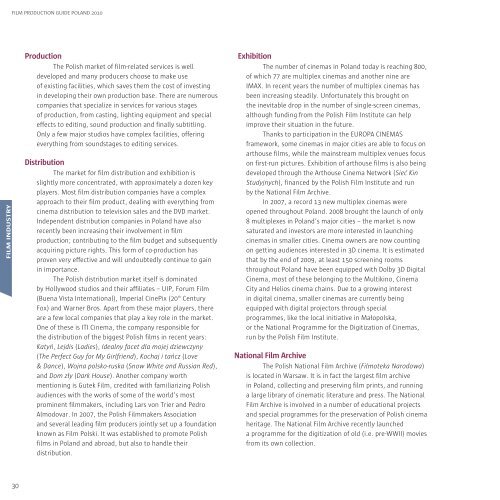Polish Cinema today - Polski Instytut Sztuki Filmowej
Polish Cinema today - Polski Instytut Sztuki Filmowej
Polish Cinema today - Polski Instytut Sztuki Filmowej
Create successful ePaper yourself
Turn your PDF publications into a flip-book with our unique Google optimized e-Paper software.
Film industry<br />
FILM PRODUCTION GUIDE POLAND 2010<br />
30<br />
Production<br />
The <strong>Polish</strong> market of film-related services is well<br />
developed and many producers choose to make use<br />
of existing facilities, which saves them the cost of investing<br />
in developing their own production base. There are numerous<br />
companies that specialize in services for various stages<br />
of production, from casting, lighting equipment and special<br />
effects to editing, sound production and finally subtitling.<br />
Only a few major studios have complex facilities, offering<br />
everything from soundstages to editing services.<br />
distribution<br />
The market for film distribution and exhibition is<br />
slightly more concentrated, with approximately a dozen key<br />
players. Most film distribution companies have a complex<br />
approach to their film product, dealing with everything from<br />
cinema distribution to television sales and the DVD market.<br />
Independent distribution companies in Poland have also<br />
recently been increasing their involvement in film<br />
production; contributing to the film budget and subsequently<br />
acquiring picture rights. This form of co-production has<br />
proven very effective and will undoubtedly continue to gain<br />
in importance.<br />
The <strong>Polish</strong> distribution market itself is dominated<br />
by Hollywood studios and their affiliates – UIP, Forum Film<br />
(Buena Vista International), Imperial CinePix (20 th Century<br />
Fox) and Warner Bros. Apart from these major players, there<br />
are a few local companies that play a key role in the market.<br />
One of these is ITI <strong>Cinema</strong>, the company responsible for<br />
the distribution of the biggest <strong>Polish</strong> films in recent years:<br />
Katyń, Lejdis (Ladies), Idealny facet dla mojej dziewczyny<br />
(The Perfect Guy for My Girlfriend), Kochaj i tańcz (Love<br />
& Dance), Wojna polsko-ruska (Snow White and Russian Red),<br />
and Dom zły (Dark House). Another company worth<br />
mentioning is Gutek Film, credited with familiarizing <strong>Polish</strong><br />
audiences with the works of some of the world’s most<br />
prominent filmmakers, including Lars von Trier and Pedro<br />
Almodovar. In 2007, the <strong>Polish</strong> Filmmakers Association<br />
and several leading film producers jointly set up a foundation<br />
known as Film <strong>Polski</strong>. It was established to promote <strong>Polish</strong><br />
films in Poland and abroad, but also to handle their<br />
distribution.<br />
exhibition<br />
The number of cinemas in Poland <strong>today</strong> is reaching 800,<br />
of which 77 are multiplex cinemas and another nine are<br />
IMAX. In recent years the number of multiplex cinemas has<br />
been increasing steadily. Unfortunately this brought on<br />
the inevitable drop in the number of single-screen cinemas,<br />
although funding from the <strong>Polish</strong> Film Institute can help<br />
improve their situation in the future.<br />
Thanks to participation in the EUROPA CINEMAS<br />
framework, some cinemas in major cities are able to focus on<br />
arthouse films, while the mainstream multiplex venues focus<br />
on first-run pictures. Exhibition of arthouse films is also being<br />
developed through the Arthouse <strong>Cinema</strong> Network (Sieć Kin<br />
Studyjnych), financed by the <strong>Polish</strong> Film Institute and run<br />
by the National Film Archive.<br />
In 2007, a record 13 new multiplex cinemas were<br />
opened throughout Poland. 2008 brought the launch of only<br />
8 multiplexes in Poland’s major cities – the market is now<br />
saturated and investors are more interested in launching<br />
cinemas in smaller cities. <strong>Cinema</strong> owners are now counting<br />
on getting audiences interested in 3D cinema. It is estimated<br />
that by the end of 2009, at least 150 screening rooms<br />
throughout Poland have been equipped with Dolby 3D Digital<br />
<strong>Cinema</strong>, most of these belonging to the Multikino, <strong>Cinema</strong><br />
City and Helios cinema chains. Due to a growing interest<br />
in digital cinema, smaller cinemas are currently being<br />
equipped with digital projectors through special<br />
programmes, like the local initiative in Małopolska,<br />
or the National Programme for the Digitization of <strong>Cinema</strong>s,<br />
run by the <strong>Polish</strong> Film Institute.<br />
national Film archive<br />
The <strong>Polish</strong> National Film Archive (Filmoteka Narodowa)<br />
is located in Warsaw. It is in fact the largest film archive<br />
in Poland, collecting and preserving film prints, and running<br />
a large library of cinematic literature and press. The National<br />
Film Archive is involved in a number of educational projects<br />
and special programmes for the preservation of <strong>Polish</strong> cinema<br />
heritage. The National Film Archive recently launched<br />
a programme for the digitization of old (i.e. pre-WWII) movies<br />
from its own collection.


